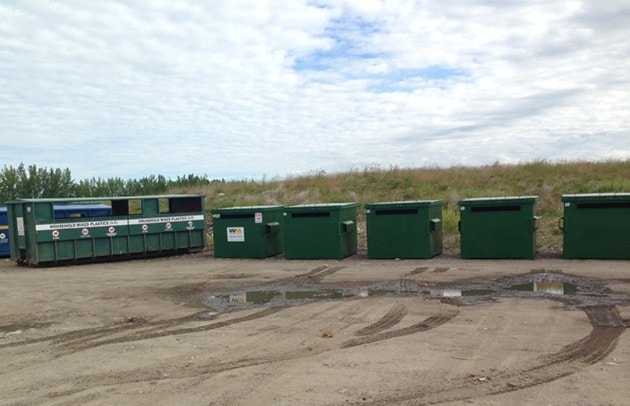Curbside recycling starts with cardboard
Vanderhoof residents can soon recycle corrugated cardboard in the comfort of their own home for free.
With an aim to start in January 2017, the Nechako Waste Reduction Initiative looks to provide a weekly curb-side cardboard pickup service for homes in the District of Vanderhoof.
Residential corrugated cardboard was banned by the Regional District of Bulkley-Nechako from Vanderhoof’s landfill on July 1 in a regional district-wide effort to reduce waste. Additional bins for cardboard were placed at the local transfer station to facilitate recycling.
“There are residents who can’t get up to the transfer station to dispose of corrugated cardboard,” said NWRI’s Trinda Elwert, who presented the project to the district council on Nov. 21.
Once the service is up and running, the initiative hopes to expand the program to pick up other recyclable materials, Elwert added.
The proposed service will synchronize pickup days with existing garbage collection services: Mondays for homes on the northern shore of the Nechako River, Tuesdays for Vanderhoof west of Burrard Avenue, Wednesdays for residences south of Highway 16, and Thursdays for Vanderhoof east of Burrard Avenue.
The free service, staffed by two Mobile Work Crew members of Nechako Valley Community Services Society, will cost $24,000 a year — $10,000 of which will be provided by the District of Vanderhoof in 2017 while the initiative seeks alternate grant funding.
Successful start to local animal welfare work
Turning one year old this November, Vanderhoof’s Great Nechako Animal Welfare Society provided an update of its work to the district council on Nov. 21.
In the past year, Vanderhoof’s feral cat population was controlled by having 32 cats trapped, neutered, and returned to the community. Thirty-three kittens were rescued and handed over to Prince George’s SPCA for more support. There are about six feral cat colonies within district limits, some near grocery stores and trailer parks, GNAWS’ Kathleen Hebb said.
The society also started a barn cat program to provide cats, who would otherwise be exposed to the winter elements, with a better environment for living.
Next year, GNAWS is looking to start an education program within schools to teach students the proper ways to care and behave with animals. Existing models currently take place in Burns Lake and some First Nations communities in the region.
With requests for assistance from surrounding communities such as Saik’uz, Nadleh Whut’en, Cluculz Lake, and Fraser Lake, the amount of work is not lacking, but number of volunteers are, Hebb said.
GNAWS’s first annual general meeting will take place on Jan. 21 at 3 p.m. in Vanderhoof Public Library.
New designated funds for Vanderhoof in times of transition
An industrial fund and a promotion/attraction/retention of work force fund will be created by allocating $10 of property tax revenues per $1,000 of Class 4 properties’ assessment.
The industrial fund would be used in times of fluctuating property tax revenue due to assessment, and may also be used by the district council to diversify the economy, in order to add to municipal property tax base.
The work force fund is dedicated for promoting Vanderhoof as a livable community and maintaining a viable work force. Its policy remains under development by district staff, in consultation with similar policies of surrounding communities. For example, perimeters will be set in deciding which labour shortage — such as ultrasound technicians, as suggested by Thiessen — to target.
Community Forest team formed
A Working Plan Committee for Vanderhoof Community Forest is now formed by district councillors Ken Young and Kevin Moutray, as well as community members Mark Churchill, Richard Burkholder, and Trinda Elwert.
Salvation Army invited to Vanderhoof
The District of Vanderhoof is inviting Salvation Army to set up shop in town.
The international Christian charity will likely not be setting up a church along with its other operations, as is customary at other districts, in the over 20-church strong community of Vanderhoof, said Mayor Gerry Thiessen.
With about 20 per cent of people at Prince George’s location logging in with Vanderhoof’s postal code, SA’s expansion will increase the capacity of Vanderhoof to satisfy social needs, Thiessen added.
Proposed focus for the new location includes textile recycling, a thrift store, social development, and transitional housing.
Canadian Mosaic visits Vanderhoof next June
Vanderhoof will be one of the Canadian Mosaic Project’s 150 stops across the country to celebrate Canada’s 150th birthday.
The project, created by Canadian photographer Tim Van Horn, will bring into town a mobile education pavilion known as To Canada With Love, which includes three mosaics of Canadian portraits captured in various towns and communities of the country.
Visitors of the pavilion are invited to record and answer what Canada means to them in 150 seconds, and participate in a mosaic that will be published on Canada Day 2018.
- with files from the District of Vanderhoof
